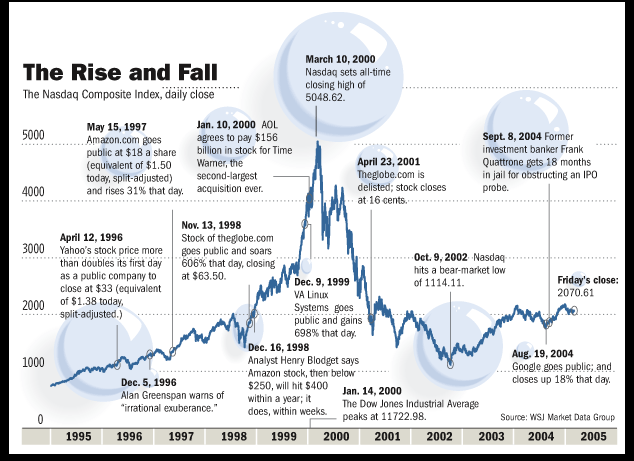 Ahoy there Trader! ⚓️
Ahoy there Trader! ⚓️
It’s Phil…
The Bubble That Changed Everything
The late 1990s were a whirlwind of optimism and ambition. The internet was hailed as the next industrial revolution, and investors scrambled to ride the wave of technological transformation. The promise of the internet was immense: revolutionising communication, commerce, and daily life. But as history would soon teach us, when hype outweighs fundamentals, trouble looms.
During this time, Nasdaq became the poster child of internet mania, skyrocketing from a modest 374 points in 1991 to a jaw-dropping 5,132 by March 2000. Investors abandoned tried-and-true methods of analysing company fundamentals. Instead, they chased the latest dotcom IPOs with little more than FOMO-fuelled optimism. A startup didn’t need profits—or even a viable business model. All it took was a .com in its name and a flashy promise of growth.

The Boom That Couldn’t Last
At its core, the Dotcom Bubble was driven by overconfidence. Companies and investors believed the internet would rewrite the rules of business overnight.
- A Surge in Funding: Venture capitalists poured billions into internet startups. Many lacked profitability or a sustainable model but promised outsized returns based on speculative metrics like website traffic.
- Media Hype: Publications such as Forbes, Bloomberg, and The Wall Street Journal glorified the “get big fast” mentality. The narrative wasn’t about building businesses but about grabbing market share—profitability be damned.
- Easy Money: Low interest rates made funding abundant and accessible. With fewer barriers to entry, startups multiplied like rabbits, creating a saturated and speculative market.
The result? Valuations that made no sense. By 1999, tech companies traded at 50-100x their annual sales, with some IPOs surging hundreds of percent on their first trading day.
Important Question: Are you ready to trade smarter?
When you’re ready – Dive Deeper Into a Profitable Rules Based Trading System
This Proven 3-Step “10 min/Day” 6-Figure Unconventional Recession Proof SPX Income System Unlocks $500-$5,000+ Days FAST! …
When the Music Stopped
The bubble began deflating in early 2000. Rising interest rates, coupled with warnings from analysts about overvaluation, started to spook investors.
- March 2000 – The Peak: Nasdaq reached its all-time high of 5,132 points. The rally had lifted unprofitable companies to unsustainable valuations.
- April 2000 – The Collapse Begins: As confidence waned, the Nasdaq plummeted 34% by May. Stocks like Pets.com, which were once darlings of the market, became cautionary tales.
- 2001–2002 – Rock Bottom: By October 2002, Nasdaq hit 1,108 points—down 78% from its peak. The crash erased nearly $5 trillion in market value. Hundreds of companies folded, leaving investors broke and venture capitalists burned.
Why It Happened
The causes of the Dotcom Bubble are as relevant today as they were then:
- Overvaluation: Investors ignored traditional metrics like revenue and cash flow, focusing instead on website traffic and future potential.
- Speculative Hype: The media and analysts fuelled unrealistic expectations, creating a frenzy of uncritical investment.
- Venture Capital Overload: Cheap funding made it easy for startups to raise capital, often without viable plans for long-term sustainability.
Learning from the Crash
The Dotcom Bubble offers valuable lessons for investors navigating today’s speculative markets:
- Analyse Fundamentals: Look for strong business models and cash flow generation, not just flashy promises of growth.
- Avoid FOMO: Don’t chase trends just because everyone else is. Stick to investments backed by logic, not hype.
- Be Wary of Overvaluation: Watch for inflated P/E ratios or extreme beta coefficients, which often signal risk in downturns.
A Familiar Tune in AI and Tech Today?
History often rhymes, and some see echoes of the Dotcom Bubble in today’s tech and AI markets. While the sectors hold immense potential, the speculative frenzy surrounding them is eerily familiar. As we marvel at the promise of AI, it’s worth asking: are we learning from the past or setting the stage for another painful lesson?
Fun Fact:
Did you know that Pets.com, one of the Dotcom era’s most infamous failures, spent $1.2 million on a Super Bowl ad – just months before collapsing? Its stock dropped from $11 to $0.19, leaving investors licking their wounds.
This failure highlights a lesson still relevant today: great marketing can’t save a bad business model.
Did you also know that Amazon’s stock price fell 94% during the Dotcom Crash?
The e-commerce giant dropped from $107 to just $6 but rebounded to become one of the world’s most valuable companies. Proof that strong fundamentals can weather any storm.
Happy trading,
Phil
Less Brain More Gain
…and may your trades be smoother than a cashmere codpiece
